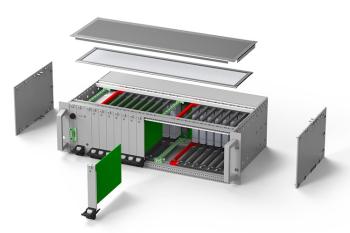Insights into Hidden Worlds
Fiber Optical Based Metrology for High-Precision Form Measurement
In order to measure characteristics that are difficult to access, like in boreholes, the commercially available sensors are often not well suited. Either, they are too big or they damage the testing object's surface. That is why fiber optical measurement systems become more and more important. They operate contact-free, with high accuracy and high measuring rates which permit the inspection in production processes.
Measuring tasks in areas with difficult access, like holes, or in delicate component surfaces requires the application of a flexible and non-contact metrology. For this reason the German Fraunhofer Institute for Production Technology IPT developed together with the company Fionec from Aachen, Germany, an optical fiber based measuring system for the high precision form metrology.
System Specification
The system is based on the low coherent interferometry measuring principle, shown in figure 1. It is composed of two main units: the first unit is a fiber based Fizeau interferometer, which is connected to a second unit to analyze the encoded distance, a Michelson interferometer. The generated interferogram is acquired by a CCD line detector and directly evaluated using an embedded microprocessor. The measurement results are available as analog (+/-10 V and 19 bits resolution) or digital signal (USB) with measuring rates of up to 15 kHz. For a measuring range of 120 µm the system achieves measurement uncertainties of 5 nm. Possible operation distances depend on the optic fiber probe design type and can achieve distances up to 3 mm.
The fiber probes are composed of an optical fiber (diameters down to 80 µm) and for the stiffness enhancement also of a ferrule of for example CFP (carbon fiber reinforced plastic) or Aluminum [1].
Form Metrology
The solution concepts for the fiber optical based form metrology comprehend the integration of this technology in commercialized measuring equipments (for example coordinate measuring machines or form measuring stations) as well as the specification, design and construction of fiber probes (fig. 2a). The development and construction of individual high precision measuring equipments for special measuring tasks is also possible (fig. 2b).
In order to investigate the measuring system's applicability and also the measurability of diverse form characteristics the developed system was integrated in an industrial form measuring station. A complete integration was secured by coupling the analog measuring system output back in the measuring station. The synchronization between position and measurement value is implemented using a TTL trigger signal generated by the measuring station.
By means of this integration all existing measuring station's metrological routines can be used, as well as all the mea-surement evaluation tools conforming to ISO. Examples of possible form inspection are roundness, cylindricity, straightness, parallelism, run-out, axial run-out and conicity all according to DIN/ISO 1101.
In parallel the Fraunhofer IPT developed individual high precision measuring equipment and software for the micro borehole inspection (roundness and cylindricity) and for the shaft inspection (roundness and run-out) [2].
Applications
Form inspection based on fiber optical sensors can be executed in several high precision components, for example in micro holes in diesel injection nozzles. Those holes exhibit diameters of 125 µm (with falling tendency) and a characteristic conical form (fig. 3a). By using fiber probes with diameters of 80 µm a direct form inspection is made possible. A similar measurement task is the inspection of fuel and hydraulic valves and nozzles, which feature boreholes with diameters in a few millimeters range (fig. 3c). A further measurement task which shows a demand on flexible metrology is the roundness and run-out inspection of gear wheels. Using fiber optical sensors a flexible non-contact inspection of gear wheels with diverse diameters, tooth crest form and quantity is possible in high measuring rates (fig. 3b).
Based on the miniaturized fiber probe size the measurement on form features with difficult access is made practicable. Examples are stepped shafts (fig. 3d) and structured grinding disks (fig. 3e). These structured grinding disks demand in addition to the miniaturized fiber probe size a non-contact measurement because of its abrasive surface.
The possible high measuring rates permit also the form inspection in production processes. The run-out inspection of shafts in the quality test by high rotation velocities (600 rpm) is an example.
By the application of a fiber switch several fiber probes can be scanned using only a single evaluation unit, creating the possibility of a multi sensor inspection. With this concept fiber optical measurement equipments analog to pneumatical multi sensor measurement stations can be developed [2].
Future Steps
At Fraunhofer IPT further sensor concepts are planned, like the design of fiber probes for roughness measurement as well as the probe miniaturization under 80 µm. Another focus is the construction of a fiber probe with a built-in rotation unit for measuring boreholes in several surface angles, as well as the measurement of a complete gear tooth.
References
[1] Depiereux, F., König, N., Pfeifer, T. and Schmitt, R.: „Fiber-Based White-Light Interferometer With Improved Sensor Tip and Stepped Mirror", IEEE Transactions on instrumentation and measurement, vol. 56, no. 6, 2007, pp. 2279-2283.
[2] Schmitt, R., König, N., Mallmann, G. and Depiereux, F.: „Fiber-optical measurement of form deviations of rotation-symmetric part", Measurement, Vol. 43, Edition 5, Juni 2010, pp. 714-718.
Contact
Fraunhofer-Institut für Produktionstechnologie IPT
Steinbachstr. 17
52074 Aachen
Germany
+49 241 8904-0
+49 241 8904 198




